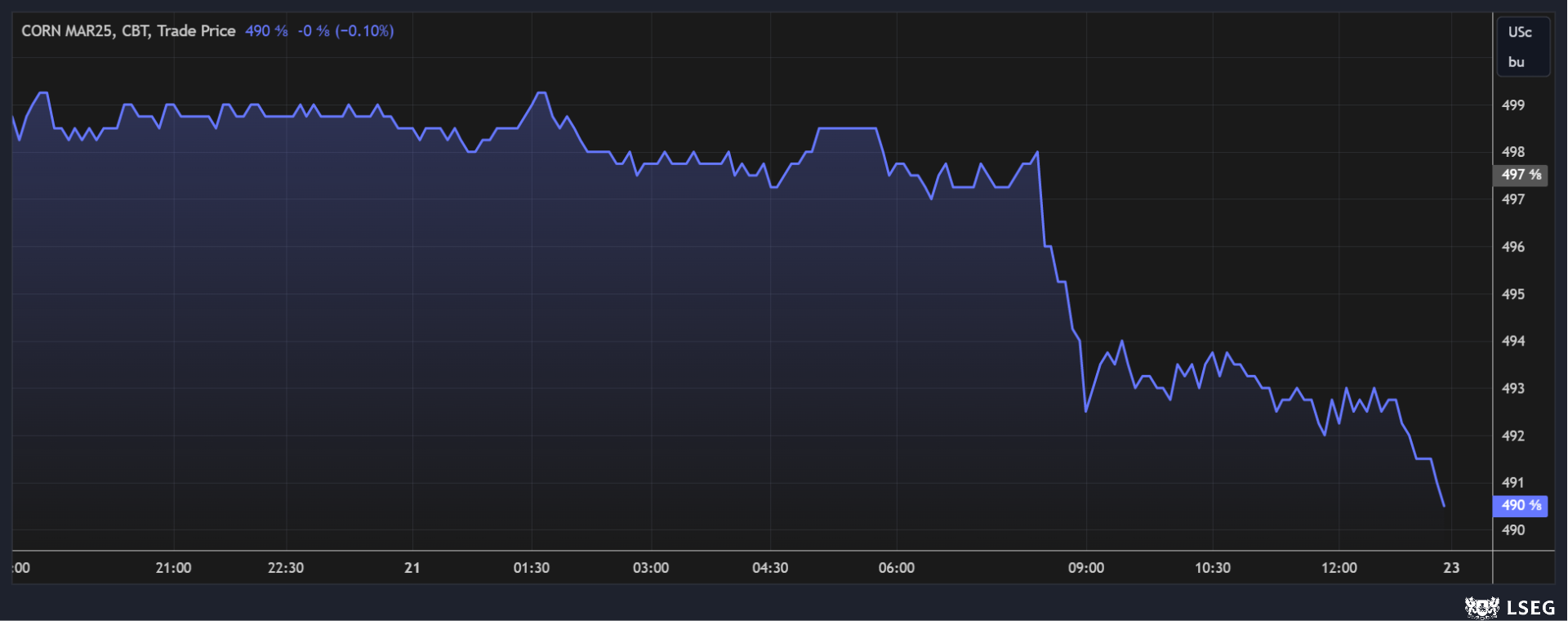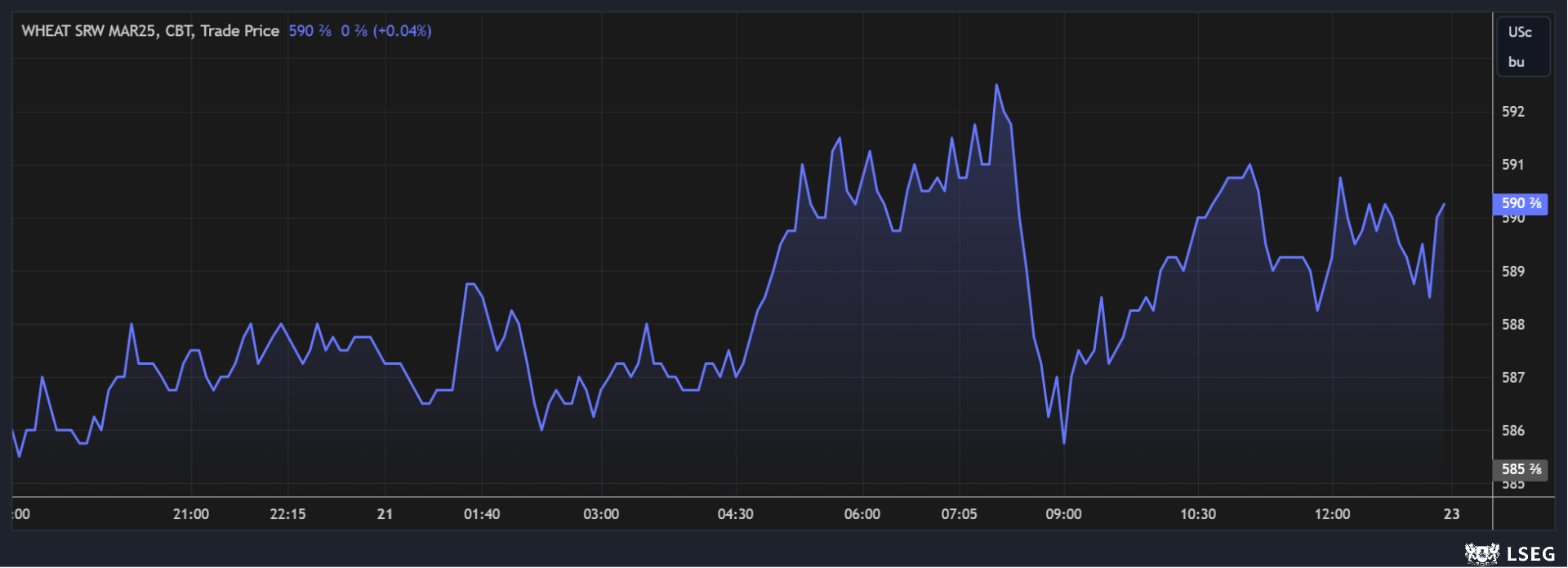Don’t miss the latest market commentary from the Farm Futures team. Sign up for the complimentary morning and afternoon market newsletters!
With USDA’s Agricultural Outlook Forum approaching, the question of how many corn acres U.S. farmers will plant in 2025 is quickly heating up. The general consensus is corn plantings will trend higher this season, due to a runup in prices over the past several months. That led to an ample round of technical selling on Friday that pushed prices 1.5% lower. Soybeans also moved into the red, while winter wheat prices found some mild to moderate forward momentum.
Very little rain or snow is expected in the central U.S. over the next several days, but parts of the Northern Plains and upper Midwest could catch some trace amounts between Saturday and Tuesday, per the latest 72-hour cumulative precipitation map from NOAA. Later on, NOAA’s new 8-to-14-day outlook predicts seasonally wet weather for the central U.S. between February 28 and March 6, with warmer-than-normal temperatures spreading across the Plains during this time.
On Wall St., the Dow tumbled 785 points lower as yesterday’s market selloff continued in earnest on Friday. Consumer sentiment is down as fears of higher inflation persist. Energy futures were also in the red on geopolitical uncertainties in the U.S. and abroad, with crude oil spilling more than 2.75% lower to $70 per barrel. Gasoline losses hovered around 2.5%. The U.S. Dollar firmed moderately.
On Thursday, commodity funds were net buyers of corn (+1,000), soybeans (+4,000), soymeal (+1,500) and soyoil (+2,500) contracts but were net sellers of CBOT wheat (-2,000).
Corn prices saw the latest rally run aground
Prices shifted 1.5% lower following a round of technical selling and profit-taking after briefly touching 18-month highs. March futures fell 7.5 cents to $4.9050, with May futures down 8 cents to $5.0475.

Corn basis bids were steady to mixed after trending as much as 3 cents higher at an Illinois river terminal and as much as 3 cents lower at an Iowa processor on Friday.
Old crop corn sales eased 5% below the prior four-week average this past week. Total sales were on the very high end of analyst estimates, which ranged between 35.4 million and 63.8 million bushels. Cumulative sales for the 2024/25 marketing year remain moderately ahead of last year’s pace, with 993.9 million bushels.
Corn export shipments reached a marketing-year high of 63.2 million bushels, which was 16% better than the prior four-week average. Mexico, Japan, South Korea, Spain and Vietnam were the top five destinations.
Ahead of next week’s USDA Agricultural Outlook Forum, CoBank estimates that U.S. farmers will plant 94.55 million acres of corn this year, up 4% from 2024. CoBank also estimates U.S. soybean plantings will fall to 84.0 million acres, a year-over-year decline of 3.6%, if realized.
Corn settlements on Thursday were for 415,140 contracts.
Soybean prices stumbled a bit in end-of-week trading
Prices shifted more than 0.5% lower following a round of technical selling on Friday. Traders reviewed the latest harvest progress in South American and a fairly pedestrian round of export sales data released this morning. March futures dropped 6 cents to $10.3950, with May futures down 5.75 cents to $10.5725.

The rest of the soy complex also eroded into the red today. March soymeal futures trended almost 0.5% lower, while March soyoil futures shifted more than 0.75% lower.
Soybean basis bids were steady to firm after tracking 5 cents higher at an Indiana processor and rising 8 cents at an Illinois river terminal on Friday.
Soybean exports found 18.4 million bushels in combined old and new crop sales last week. Old crop sales faded 23% below the prior four-week average. Total sales were toward the higher end of analyst estimates, which ranged between 3.7 million and 22.0 million bushels. Cumulative sales for the 2024/25 marketing year are still moderately above last year’s pace, with 1.324 billion bushels.
Soybean export shipments shifted 27% below the prior four-week average, with 27.2 million bushels. China, Mexico, Egypt, Pakistan and the Netherlands were the top five destinations.
Abiove, a Brazilian grain traders association, is in court challenging a new state law that levies a 1.8% tax on grain exports that will begin to take place next week at the port of Itaqui in Maranhao (one of the country’s major northern export hubs). The group is arguing that the tax will make Brazil less competitive versus Argentina and the United States. “Grain trading is a low margin business [and] 1.8% is bigger than the margin of the business,” according to Abiove head Andre Nassar.
Soybean settlements on Thursday were for 299,261 contracts.
Wheat prices were mixed on Friday
Winter wheat prices tested small to moderate gains on extended winterkill concerns both in the U.S. and in Russia, while spring wheat prices incurred modest losses. March Chicago SRW futures gained 4.75 cents to $5.9025, March Kansas City HRW futures added 1.25 cents to $6.0875, and March MGEX spring wheat futures dropped 2.25 cents to $6.3050.

Wheat exports found combined old and new crop sales totaling 23.2 million bushels. Old crop sales were 31% better than the prior four-week average. Total sales were on the very high end of analyst estimates, which ranged between 11.0 million and 23.9 million bushels. Cumulative sales for the 2024/25 marketing year remain moderately ahead of last year’s pace, with 530.0 million bushels.
Wheat export shipments slumped 43% below the prior four-week average, with 8.6 million bushels. South Korea, Mexico, Panama, Japan and Taiwan were the top five destinations.
French farm office FranceAgriMer reported that 74% of the country’s 2024/25 soft wheat crop was in good-to-excellent condition through February 17, up a point from the prior week and moderately better than year-ago results of 69%. France is Europe’s top grain producer.
And finally, be sure to read the latest edition of “7 ag stories you can’t miss” if you haven’t visited our website in a while. Today’s stories include a look on how Canadian tariffs could hurt U.S. farmers, a look at the government’s latest bird flu response and more – click here to get started.
CBOT wheat settlements on Thursday were for 116,570 contracts.